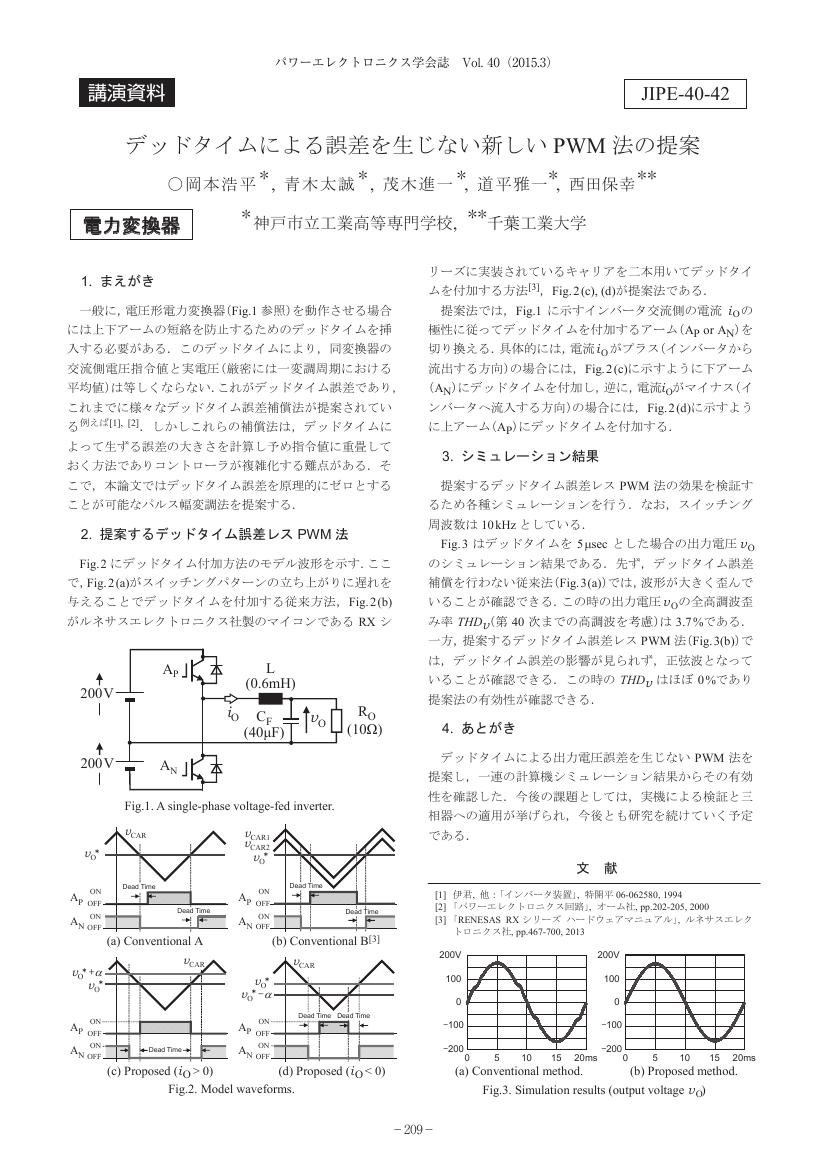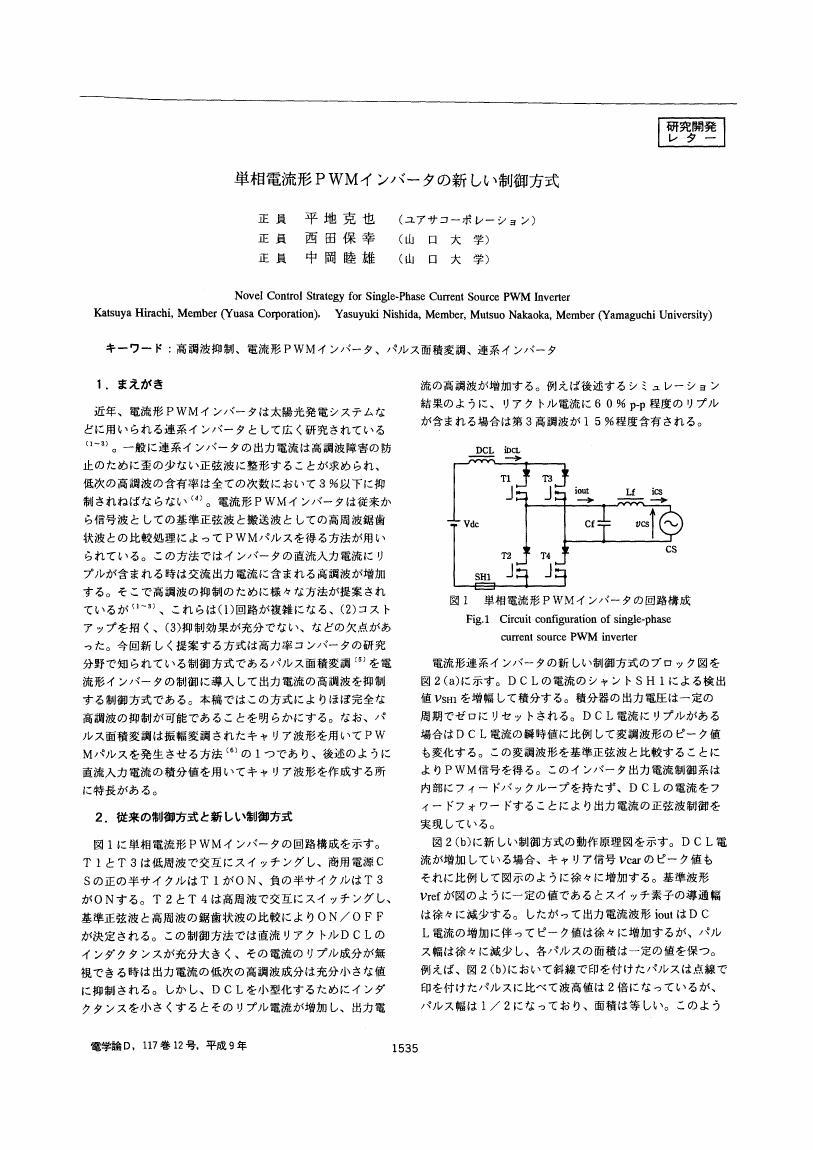9 0 0 0 OA デッドタイムによる誤差を生じない新しいPWM 法の提案
- 著者
- 岡本 浩平 青木 太誠 茂木 進一 道平 雅一 西田 保幸
- 出版者
- パワーエレクトロニクス学会
- 雑誌
- パワーエレクトロニクス学会誌 (ISSN:13488538)
- 巻号頁・発行日
- vol.40, pp.209, 2014-03-31 (Released:2016-04-08)
- 参考文献数
- 3
- 被引用文献数
- 1 1
6 0 0 0 OA 高校運動部員の部活動ストレッサーに対する認知的評価尺度の再構成
- 著者
- 渋倉 崇行 西田 保 佐々木 万丈
- 出版者
- 一般社団法人 日本体育学会
- 雑誌
- 体育学研究 (ISSN:04846710)
- 巻号頁・発行日
- pp.0807090077-0807090077, (Released:2008-07-10)
- 参考文献数
- 32
- 被引用文献数
- 5 2
The purpose of this study was to reconstruct a cognitive appraisal scale for high school athletes (Shibukura and Mori, 2004), and to examine the scale's reliability and validity. The subjects were 1370 first and second year high school athletes (903 males and 467 females). They were required to complete a questionnaire that consisted of a cognitive appraisal scale and a stress-coping scale for high school athletes. In this study we tried to devise a cognitive appraisal scale that contained “threat” and “challenge” as a primary appraisal and “controllability” as a secondary appraisal. First, as a result of factor analysis, it was revealed that a cognitive appraisal scale for high school athletes consisted of the three factors mentioned above. In this way, the cognitive appraisal scale was reconstructed. Second, the reliability of the scale was examined through the split-half method and the test-retest method. Furthermore, the content validity and the factorial validity were verified. Finally, multiple regression analyses were performed in order to examine the relationship of cognitive appraisal and coping. It became clear that a cognitive appraisal scale explained stress-coping, and the scale's predictive validity was supported. Consequently, a cognitive appraisal scale for high school athletes that contained “challenge”, “threat” and “controllability” was reconstructed, and it was considered that this scale would contribute to clarification of the psychological stress process and effective stress management.
3 0 0 0 OA 自己成長力に関する研究
- 著者
- 速水 敏彦 西田 保 坂柳 恒夫
- 出版者
- 名古屋大学
- 雑誌
- 名古屋大學教育學部紀要. 教育心理学科 (ISSN:03874796)
- 巻号頁・発行日
- vol.41, pp.9-24, 1994-12
- 被引用文献数
- 1
国立情報学研究所で電子化したコンテンツを使用している。
2 0 0 0 OA 消化管出血時における血液生化学的検査値の検討
- 著者
- 岩谷 周一 福島 晴夫 大隅 雅夫 田中 稔 平沢 敏昭 西田 保二 長町 幸雄
- 出版者
- Japan Surgical Association
- 雑誌
- 日本臨床外科医学会雑誌 (ISSN:03869776)
- 巻号頁・発行日
- vol.50, no.11, pp.2308-2312, 1989-11-25 (Released:2009-04-21)
- 参考文献数
- 11
1983年から1987年までの5年間に群馬大学第1外科に入院した消化管出血例243例についてHb, MCV, BUN, BUN/Cr,を疾患部位別に比較し,出血部位,出血量及び出血状況の推定の可能性を検討した.結果:貧血群のMCVの比較では大腸出血例で食道のそれに比べ有意に小さかった.BUNが20mg/dl以上の高値を示すものは大腸よりも上部消化管で有意に多く,貧血群のBUNは食道の場合が胃十二指腸及び大腸よりも有意に高値であった.BUN/Cr>30の症例は上部消化管の21%に対し,大腸で1.9%と少なかった.食道疾患ではHbとBUN/Crとの間で相関(相関係数r=-0.6)が認められた.まとめ:消化管出血時,BUN/Cr>30を呈する症例は出血が上部消化管由来である可能性が極めて高く,また,出血量の推定も可能であることが示唆された.
1 0 0 0 OA ウェーブレット変換による三相PWM 変換器の時間周波数解析
- 著者
- 井本 涼太 茂木 進一 道平 雅一 西田 保幸
- 出版者
- パワーエレクトロニクス学会
- 雑誌
- パワーエレクトロニクス学会誌 (ISSN:13488538)
- 巻号頁・発行日
- vol.40, pp.176-181, 2014-03-31 (Released:2016-04-08)
- 参考文献数
- 7
- 被引用文献数
- 10 13
A three-phase voltage-fed converter operated by a two-phase PWM scheme offers relatively high ac voltage, low switching times, and low switching losses in comparison to that operated by a three-phase PWM scheme. However, the harmonics involved in the ac-side voltages and currents produced in the two-phase PWM scheme are distributed over a wide frequency range, which can be a significant drawback depending on its applications. Therefore the authors examine the problem using wavelet transform.
1 0 0 0 OA 単相電流形PWMインバータの新しい制御方式
- 著者
- 平地 克也 西田 保幸 中岡 睦雄
- 出版者
- The Institute of Electrical Engineers of Japan
- 雑誌
- 電気学会論文誌D(産業応用部門誌) (ISSN:09136339)
- 巻号頁・発行日
- vol.117, no.12, pp.1535-1536, 1997-11-20 (Released:2008-12-19)
- 参考文献数
- 6
- 被引用文献数
- 3 2
1 0 0 0 OA 3相昇降圧形高力率スイッチングコンバータ
- 著者
- 西田 保幸
- 出版者
- The Institute of Electrical Engineers of Japan
- 雑誌
- 電気学会論文誌D(産業応用部門誌) (ISSN:09136339)
- 巻号頁・発行日
- vol.115, no.4, pp.410-419, 1995-03-20 (Released:2008-12-19)
- 参考文献数
- 13
The harmonic pollution caused by ac-to-dc converters has been our great concern. To overcome the problem, several Power-Factor-Correction (PFC) converters have been developed and applied in practice in recent years.However, several power converter systems, such as motor drive system with a wide V/F control range, uninterruptible power supply system, and dc power supply system with an universal input voltage range, require an ac-to-dc converter or an off-line converter (pre-regurator) with a wide output-voltage control range to obtain high efficiency. But the most conventional PFC converters employ a Voltage-Fed or Current-Fed type topology and they have lower or upper limitation of the output-voltage control range. Thus, they do not realize sufficiently high system efficiency.On the other hand, a Buck/Boost converter has a wide control range of the output voltage and acts PFC operation under an appropriate control technique. Thus, the study of a possibility about the Buck/Boost ac-to-dc converter with PFC and a wide output-voltage control range is important to realize harmonic-free and efficient power conversion systems.In this paper, the author proposes a three-phase bridge-type ac-to-dc converter system with a high input power factor and a wide output-voltage control range. The controller of the proposed system includes following two new techniques. One is the “Pulse-Space-Modulation” to compensate modulation errors in conventional Pulse-Width-Modulation caused by dc current ripples or fluctuations of the current pulse amplitude. The other is a switching pulse pattern generator, using the idea of equivalent pulse current source for the bridge, to simplify the pulse pattern generation process.In the following, the paper describes the proposed converter system, the control and modulation principles, and experimental results that show the reliability and usefulness of the proposed Buck/Boost converter system. Finally, the paper concludes the contents of this paper.
1 0 0 0 IR 負けず嫌いとスポーツ動機づけの理解に向けて
- 著者
- 西田 保 佐々木 万丈 北村 勝朗 磯貝 浩久 齊藤 茂 NISHIDA Tamotsu SASAKI Banjou KITAMURA Katsuro ISOGAI Hirohisa SAITO Shigeru
- 出版者
- 名古屋大学総合保健体育科学センター
- 雑誌
- 総合保健体育科学 (ISSN:02895412)
- 巻号頁・発行日
- vol.37, no.1, pp.13-21, 2014
Previous studies of motivation have assumed that in general, success breeds positive feelings and motivation while failure generates negative feelings and dampens motivation. However, a closer look at comments made by athletes in interviews reveals that in many cases, regret about losing a game can actually transform itself into a strong desire to win the next competition. In order to promote an academic study of the link between the feeling of not wanting to lose and motivation, this paper summarized the presentations and discussions that got underway at the Round Table Discussion, which was organized as part of the 2013 Japan Annual Congress of Sport Psychology. The authors described actual conditions and research perspectives of the "hating to lose" mentality based on the results of questionnaires, the expertise of elite athletes, and mental training for athletes". It is hoped that the Round Table Discussion will generate further research in this area.
1 0 0 0 OA 高校運動部活動における心理社会的スキルの日常生活への般化:
- 著者
- 渋倉 崇行 西田 保 佐々木 万丈 北村 勝朗 磯貝 浩久
- 出版者
- 一般社団法人 日本体育学会
- 雑誌
- 体育学研究 (ISSN:04846710)
- 巻号頁・発行日
- vol.63, no.2, pp.563-581, 2018-12-10 (Released:2018-12-20)
- 参考文献数
- 47
- 被引用文献数
- 1
This study examined the psychosocial skills of high school extracurricular sports activities and their generalization to student daily life. In a preliminary study, we collected a wide range of psychosocial skills related to extracurricular sports activities experienced by members of high school sports clubs, and then selected questionnaire items that would be used in the present study. In Survey 1, a confirmatory factor analysis was conducted using data collected from 376 members of high school extracurricular sports clubs (265 males, 111 females) to develop two scales, one measuring psychosocial skills in extracurricular sports activities, and the other psychosocial skills in daily life. The validity and reliability of these two 9-subscale tools, both of which comprised the same items, were thus confirmed. In Survey 2, the two scales developed in Survey 1 were used to conduct three surveys of the same subjects over an interval of about 3 months, in order to determine the causal relationships between the psychosocial skills used in extracurricular activities and those used in daily life. A cross-lagged effect model was used. The study subjects were 137 high school students who were members of extracurricular sports clubs (73 males, 64 females). The results showed that the psychosocial skills needed for extracurricular sports activities could be generalized to student daily life. Generalization in the reverse direction, i.e. from skills used in everyday life to those used in extracurricular sports activities, was also evident. Furthermore, the results suggested that psychosocial skills used in extracurricular sports activities had a cyclical causal relationship with the skills used in everyday life. Finally, the significance of extracurricular sports activities and methods for actualizing this significance was discussed based on the study results.
1 0 0 0 IR Jリ-グサッカ-に関する意識調査の分析--Jリ-グ人気について
1 0 0 0 OA 次世代パワー半導体時代に相応しい交流/直流電力変換器のための制御・変調方法の探索
一般に,交流/直流電力変換器は,新幹線,ハイブリッド自動車,太陽光発電用パワーコンディショナなどの多くのアプリケーションで使用されている.そこで本研究では,交流/直流電力変換器に最適なパルス幅変調(Pulse Width Modulation; PWM)法を明らかにする.具体的には,高調波フィルタを接続しないモータドライブシステムには指令値シフト二相PWM法が,太陽光発電用パワーコンディショナや高調波フィルタを接続するモータドライブシステムにはパルス重畳二相PWM法が適していることを明らかにした.
1 0 0 0 体育における学習意欲診断システムの開発
本研究の目的は、体育における学習意欲を多面的・総合的に診断するシステムの開発であった。具体的には、(1)「体育における学習意欲」「学習意欲の支持要因」「学習行動の選好」を測定する尺度の信頼性および妥当性を、4府県下(愛知県、滋賀県、大阪府、熊本県)の公立小学校5年生および6年生の男女計1,562名を対象に検討すること、(2)体育における学習意欲の類型化をクラスター分析によって特定すること、(3)体育授業以外への興味・関心(他教科の興味、諸活動の興味と体育の楽しさ)も含めて診断システムとすること、(4)各尺度の評価基準、診断プロフィールを作成することを通して、体育における学習意欲診断システムを完成させることであった。種々検討の結果、本診断システムは、体育における学習意欲(短縮版AMPET)、学習意欲の類型(パターン)、学習意欲の支持要因、学習行動の選好、他教科や諸活動の興味、現在行われている体育授業の楽しさを測定できることが明らかとなった。また、各尺度は5段階評価によって診断プロフィールの形で示すことが可能となり、本診断システムを実際に利用した5人の体育担当教師に対して感想を求めたところ、いずれも肯定的な内容であった。以上のことから総合的に判断して、「体育における学習意欲診断システム」は、教育の実践場面において十分有効利用できるものであることが認められた。本診断システムによって提供された情報をどのようにして実際の指導に結びつけていくのかという具体的な学習指導への橋渡しが今後の課題である。


